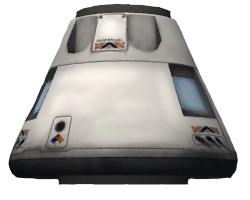Difference between revisions of "Mk1-2 Command Pod"
(→Usage: clean up formatting) |
(min. inf. upd.) |
||
| Line 7: | Line 7: | ||
Generally placed at the top of the rocket, the Mk1-2 Pod provides full command module functionality. It has twice the torque of most other manned cockpits. For small or medium-sized rockets, this is often sufficient. | Generally placed at the top of the rocket, the Mk1-2 Pod provides full command module functionality. It has twice the torque of most other manned cockpits. For small or medium-sized rockets, this is often sufficient. | ||
| − | The Mk1-2 Command Pod features a small [[radial size]] node on top, typically used for parts like the [[Mk16-XL Parachute]], [[SAS]] modules | + | The Mk1-2 Command Pod features a small [[radial size]] node on top, typically used for parts like the [[Mk16-XL Parachute]], proper sized [[Docking|docking ports]], [[SAS]] modules, [[RCS]] tanks or a [[Launch Escape System]]. It also has a large radial size node on the bottom. The Pod is outfitted with several steps under the crew hatch as well as two windows facing upwards and two more sideways windows the crew can look through during [[IVA]]s. |
[[File:Command Pod Mk1-2 Interior View.png|thumb|left|Interior View from upper-right seat of Mk1-2 Command Pod on the Launch Pad]] | [[File:Command Pod Mk1-2 Interior View.png|thumb|left|Interior View from upper-right seat of Mk1-2 Command Pod on the Launch Pad]] | ||
This command pod has a high impact tolerance of 45 m/s which makes it much more stable that most other parts. The result is that the pod is often the only part of a ship which survives a crash. That's good for the crew when the crash happened on [[Kerbin]], but not so good when on another body, because it usually means the crew is stranded without a way to get home. But note that when it comes to pure impact tolerance, the [[Mk3 Cockpit]] intended for spaceplanes has an even higher rating. | This command pod has a high impact tolerance of 45 m/s which makes it much more stable that most other parts. The result is that the pod is often the only part of a ship which survives a crash. That's good for the crew when the crash happened on [[Kerbin]], but not so good when on another body, because it usually means the crew is stranded without a way to get home. But note that when it comes to pure impact tolerance, the [[Mk3 Cockpit]] intended for spaceplanes has an even higher rating. | ||
| + | |||
| + | This pod has a decent capacity of resources, 150 units of [[electric charge]] and 30 units [[monopropellant]] gives ability to execute simpler missions without extra batteries or tanks. | ||
== Description == | == Description == | ||
Revision as of 13:45, 20 July 2014
| This page or section is in need of being brought up to date. Please help Kerbal Space Program Wiki by fixing inaccurate or outdated information. |
| Mk1-2 Command Pod | |||||
| Command pod by Kerlington Model Rockets and Paper Products Inc | |||||
| Radial size | Small, Large | ||||
| Cost | (total) | 3 800.00 | |||
| (dry) | 3 764.00 | ||||
| Mass | (total) | 4.12 t | |||
| (dry) | 4.00 t | ||||
| Drag | 0.15-0.2 | ||||
| Max. Temp. | 2400 K | ||||
| Volume | ? | ||||
| Impact Tolerance | 45 m/s | ||||
| Research | | ||||
| Unlock cost | 7 600 | ||||
| Since version | 0.16 | ||||
| Part configuration | mk1-2CommandPod.cfg | ||||
| Command module | |||||
| Pitch torque | 15.0 kN·m | ||||
| Yaw torque | 15.0 kN·m | ||||
| Roll torque | 15.0 kN·m | ||||
| Electricity required for torque |
| ||||
| Crew capacity | (maximum) | 3 | |||
| (required) | 1 | ||||
| Monopropellant | 30 | ||||
| Electric capacity | 150.0 ⚡ | ||||
| SAS level | × None | ||||
| Wing | |||||
| Lift generated | 1.4 | ||||
The Mk1-2 Command Pod is a Command Module housing three Kerbal crew members during their mission.
Usage
Generally placed at the top of the rocket, the Mk1-2 Pod provides full command module functionality. It has twice the torque of most other manned cockpits. For small or medium-sized rockets, this is often sufficient.
The Mk1-2 Command Pod features a small radial size node on top, typically used for parts like the Mk16-XL Parachute, proper sized docking ports, SAS modules, RCS tanks or a Launch Escape System. It also has a large radial size node on the bottom. The Pod is outfitted with several steps under the crew hatch as well as two windows facing upwards and two more sideways windows the crew can look through during IVAs.
This command pod has a high impact tolerance of 45 m/s which makes it much more stable that most other parts. The result is that the pod is often the only part of a ship which survives a crash. That's good for the crew when the crash happened on Kerbin, but not so good when on another body, because it usually means the crew is stranded without a way to get home. But note that when it comes to pure impact tolerance, the Mk3 Cockpit intended for spaceplanes has an even higher rating.
This pod has a decent capacity of resources, 150 units of electric charge and 30 units monopropellant gives ability to execute simpler missions without extra batteries or tanks.
Description
| “ | This modern cockpit is designed to be fully re-useable. Its spacious cabin can hold a maximum of 3 crew. — Kerlington Model Rockets and Paper Products Inc. |
” |
Changes
- Added monopropellant storage
- Added interior view
- Initial Release

